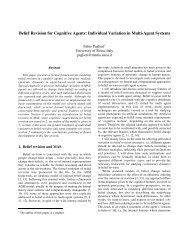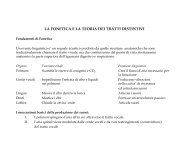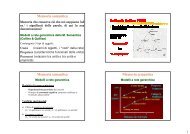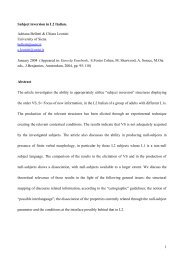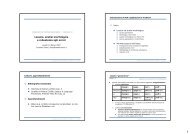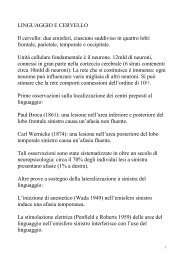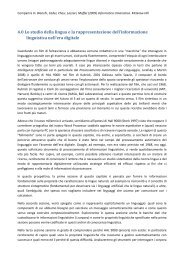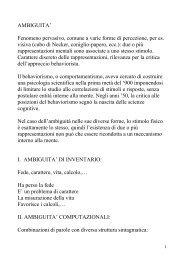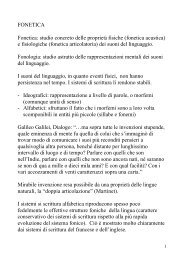Verbal morphology in Greek: the 'passive'
Verbal morphology in Greek: the 'passive'
Verbal morphology in Greek: the 'passive'
Create successful ePaper yourself
Turn your PDF publications into a flip-book with our unique Google optimized e-Paper software.
(5) a. (o Janis) plenete/ plithike<br />
<strong>the</strong> John wash-3s.pass/washed-pass-3sg<br />
„John is (be<strong>in</strong>g) washed/ John was washed‟<br />
„John washes (himself)/ John washed (himself)‟<br />
b. To aftok<strong>in</strong>ito plithike (apo ti vroxi/apo ton Jani).<br />
<strong>the</strong> car washed-pass-3s (from <strong>the</strong> ra<strong>in</strong>/from <strong>the</strong> John)<br />
„The car got washed (with <strong>the</strong> ra<strong>in</strong>)/ was washed (by John)‟<br />
<br />
<br />
<br />
Three possible read<strong>in</strong>gs:<br />
a) passive, b) reflexive („middle‟), c) anticausative. The passive read<strong>in</strong>g arises <strong>in</strong> all cases<br />
(deponents aside); <strong>the</strong> reflexive seems to require an animate subject; <strong>the</strong> anticausative is<br />
not tied to voice <strong>morphology</strong>. Make use of <strong>the</strong> term non-active voice (NACT).<br />
Voice <strong>morphology</strong>:<br />
active vs. non-active with fur<strong>the</strong>r variation <strong>in</strong> <strong>the</strong> realization of <strong>the</strong> latter.<br />
Each NACT <strong>morphology</strong> is compatible with any of <strong>the</strong> three mean<strong>in</strong>gs and vice-versa.<br />
Some questions that arise<br />
What do <strong>the</strong>se data imply for <strong>the</strong> standard A-movement approach, assum<strong>in</strong>g that <strong>the</strong> basic<br />
property of all three read<strong>in</strong>gs is <strong>the</strong> association of an <strong>in</strong>ternal argument with <strong>the</strong> EPP<br />
position?<br />
What is <strong>the</strong> relationship between syntax and <strong>morphology</strong> and between morphosyntax and<br />
LF?<br />
Is mean<strong>in</strong>g built <strong>in</strong>side syntax, or is it syntax that constra<strong>in</strong>s mean<strong>in</strong>g?<br />
2. The empirical evidence I: <strong>Greek</strong><br />
I. Morphology<br />
The morphologies: (a) examples = NACT voice, (b) examples = active voice<br />
Present (imperfective)<br />
(6) a. plen- ome/ ese/ ete/ omaste / osaste/ onde<br />
wash 1sg 2sg 3sg 1pl 2pl 3pl<br />
„I am (be<strong>in</strong>g) washed‟, etc.<br />
b. plen- o/ is/ i/ ume/ ete/ un(e)<br />
wash 1sg 2sg 3sg 1pl 2pl 3pl<br />
„I am wash<strong>in</strong>g/I wash (someone)‟ etc.<br />
Past imperfective<br />
(7) a. plen- omun/ osun/ otan/ omastan/ ostastan/ ondan<br />
wash 1sg 2sg 3sg 1pl 2pl 3pl<br />
„I was be<strong>in</strong>g washed‟ etc.<br />
b. (e)plen- a/ es/ e/ ame/ ate/ an<br />
wash(ed) 1sg 2sg 3sg 1pl 2pl 3pl<br />
„I was wash<strong>in</strong>g (somebody)‟ etc.<br />
Perfective aspect: <strong>the</strong> affix –th (or its allophones) and active voice <strong>in</strong>flections:<br />
Past perfective<br />
(8) a. pli- th- ik- a/ es/ e/ ame/ ate/ an<br />
wash NACT past 1sg 2sg 2sg 1pl 2pl 3pl<br />
„I was washed‟ etc.<br />
b. (e)pl<strong>in</strong>- a/ es/ e/ ame/ ate/ an<br />
wash 1sg 2sg 3sg 1pl 2pl 3pl<br />
2






